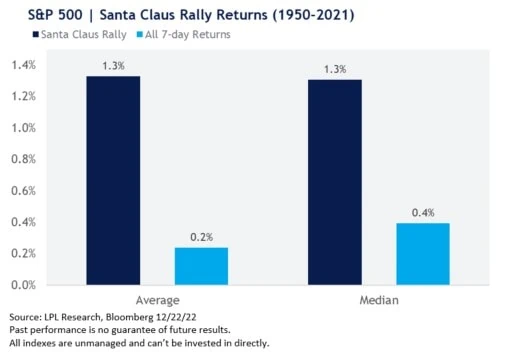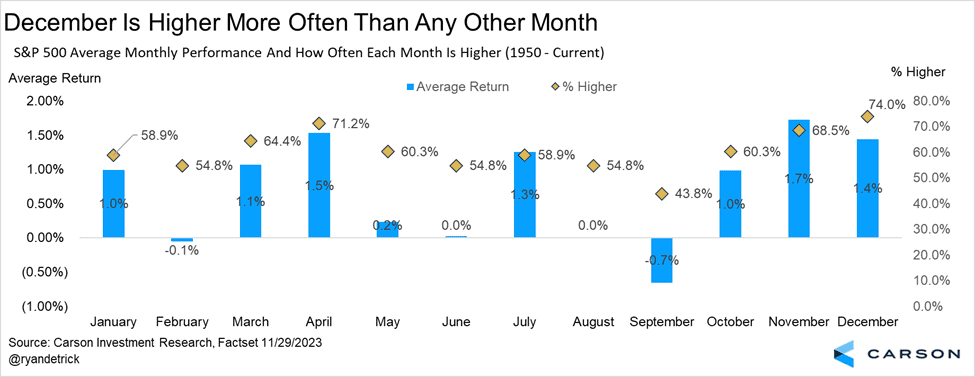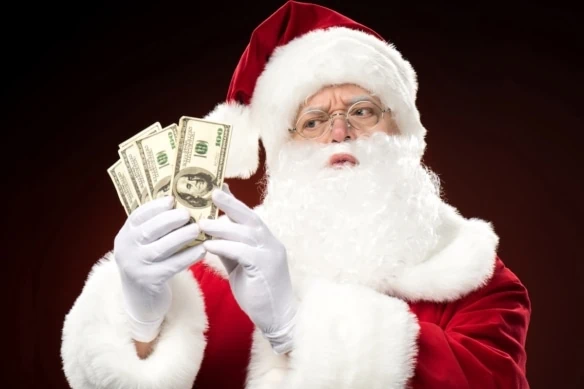Ho ho ho! The holiday season is upon us, which means snowy days will soon be here, Christmas is just weeks away, and Santa Claus is prepping his sleigh for his annual trip …
… to Wall Street?
What Is the Santa Claus Rally?

If you take even a few minutes to scan stock market-related headlines over the next month or so, you’re virtually guaranteed to come across the words “Santa Claus rally.”
Wall Street types aren’t exactly known for their sense of whimsy. But every now and then, a stock wonk will loosen their tie and coin some cheeky phrase tied to a seasonal phenomenon or goofy indicator.
A couple years back, when I was working at Kiplinger, I wrote the following:
“Experts, amateurs and idiot savants alike have forever gone to great lengths to divine the direction of share prices. Just as the ancients studied the entrails of sheep, today’s would-be market prognosticators have looked for auguries in shades of lipstick, the production of cardboard boxes, Big Mac prices, the lengths of women’s skirts and the cover of the Sports Illustrated Swimsuit Issue.”
I even mentioned this for WealthUp in a previous Weekend Tea that explained the Super Bowl Indicator.
But with the exception of “Sell in May and Go Away,” perhaps no Wall Street chestnut gets as much play as the Santa Claus rally.
So, what is it?
The definition of a Santa Claus rally can actually vary depending on who you’re talking to. Some people, for instance, loosely define it as any rally that happens in and around Christmas.
But Stock Trader’s Almanac creator Yale Hirsch, who discovered this seasonal pattern in 1972, defined it as the last five trading days of the year, plus the first two trading days of the new year. This year, for instance, if a Santa Claus rally were to take place, it would be measured between Friday, Dec. 22, and Wednesday, Jan. 3.
By and large, the Santa Claus rally period has experienced obscenely better-than-average returns. According to a 2022 note from Adam Turnquist, Chief Technical Strategist for LPL Financial, “The S&P 500 has generated average returns of 1.3% during the Santa Claus Rally period, compared to only a 0.2% average return for all rolling seven-day returns.”

The “why” behind the Santa Claus rally is even less settled.
Some people chalk it up to excitement over the strongest retail season of the year—but you could argue that’s merely seasonal trends that should already be baked in. Other people chalk it up to year-end transacting as institutional investors (especially fund managers who want to put a little window dressing on their holdings by purchasing whatever’s been working) put a wrap on their records for the year.
And still others say it’s just festive holiday vibes taking hold. No, seriously. It’s been said.
Will Santa Claus Come Again This Year?
But if it works, it works—”why” hardly seems the appropriate question here. Instead, “Will Santa come again this year” should be the top question on your mind … shouldn’t it?
Well, let’s just tackle that first.
The answer is “nobody knows,” of course. This is market experts trying to pin down whether a week- to weekslong seasonal trend will bite. But the pros have a few thoughts worth sloshing around in your head.
“The lower jobless claims highlight continued strength in the labor market. These numbers confirm the recent soft-landing narrative and expectations for lower rates next year,” David Russell, Global Head of Market Strategy at TradeStation, said after Nov. 22’s report on weekly initial unemployment filings. “An even bigger story could be what’s happening in the energy market as plunging energy prices offer hopes of lower inflation. Santa might be coming to town early this year.”
He’s hardly the only one wondering whether the presents were dropped off too early. José Torres, Senior Economist at Interactive Brokers, notes that amid a broader November-December period that’s historically strong for stocks, “another important question is whether the ‘Santa Rally’ was frontloaded, with the S&P 500 Index up 18.3% year-to-date at a time when employment growth has turned negative, according to S&P Global.”
One of my favorite brains to pick when it comes to the market’s seasonal trends is Ryan Detrick, a notoriously over-optimistic Cincinnati Bengals fan … but more importantly, Chief Market Strategist at advisory firm Carson Group.
And to be clear, he’s in the traditionalist camp when it comes to the Santa Claus rally.
“Here’s the catch,” he says. “It isn’t the whole month, or from late November until year end. It is the last five days of the year and first two days of the following year. Believe me, I will write about it a lot later in December, but by the true definition of the SCR, it won’t happen for many more weeks.”
December, he reminds us, is itself a historically strong month for stocks. Says Detrick in his recent post on the subject:
“First up, no month of the year is more likely to be higher, with stocks higher 74.0% of the time in the last month of the year. In fact, only once in history has December been the worst month of the year, and that was in 2018 (we can thank the Fed for that policy mistake back then). Fortunately, the Fed is likely done hiking and we don’t expect to see a similar policy mistake this time around.

“December is actually the third best month on average at 1.4%, with only April and November better. But what stands out to us is pre-election years tend to see even more strength, up 2.9% on average, another reason to expect higher prices before the ball drops on New Year’s Eve.”

Specifically talking about this December, Detrick says he doesn’t expect this year to be any different.
“One month ago right now nearly everyone was bearish, and the truth is many money managers have been drastically underweight stocks this year and they need to add to their positions, so we expect a lot of performance chasing into the end of the year,” Detrick says. “Should we see any early December weakness, we’d expect buyers to step in quickly. In fact, early December weakness isn’t out of the ordinary, it is later in the month when Santa tends to come.”
Should You Care?
But I wondered aloud earlier whether “Will Santa come again this year” is the question you should be asking.
If you’re a professional investor, day trader, or anyone else that makes a lot of short-term market moves, then the answer is absolutely—you should probably be thinking about opportunistic probabilities as we close out the year.
But if you’re a regular old buy-and-hold investor like me, the question you really should be asking yourself is, “Should I do anything with my portfolio now that I know what the Santa Claus rally is?”
And the answer to that?

I’ve been surrounded by market experts for more than a decade, and one of the first, best, and most frequently offered pieces of advice I’ve ever received is not to trade seasonal trends. Even professional investors have difficulty timing the markets—the chances of your average Joe doing it well are pretty low.
Indeed, earlier this week, I was talking to Thomas Cole, CEO and co-founder of ETF provider Distillate Capital, as part of my upcoming look at the best ETFs for 2024. On a whim, I asked him his thoughts on the Santa Claus rally, and he didn’t disappoint.
“Our advice is to ignore it,” Cole says. “We’re taking a very long-term view—the exercise of short-term predictions strikes us as a lot of noise.
“Unfortunately, it causes investors to do the wrong things at the wrong time. We much prefer to see our investors get involved and stay involved. The short-term game is entertaining, but transacting in it is extremely difficult and more likely to leave you behind than make money for you.”
TL;DR: If you’re already invested, the Santa Claus rally will lift your boat, too. There’s no need to do anything different. Read all you want about the phenomenon, but stick to your plan.



